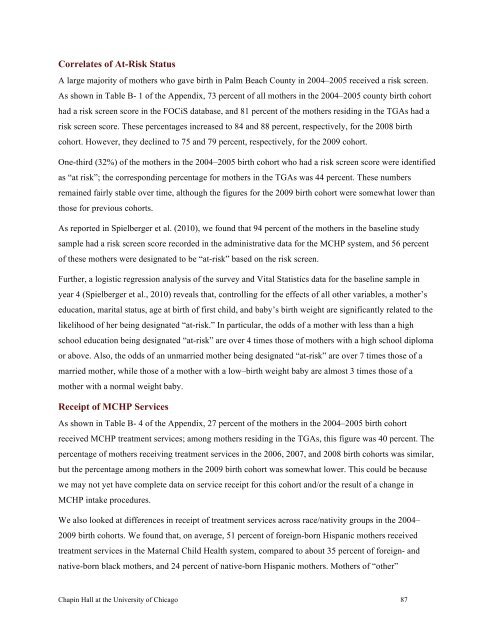2011 The Palm Beach County Family Study (Full Report)
2011 The Palm Beach County Family Study (Full Report)
2011 The Palm Beach County Family Study (Full Report)
- No tags were found...
You also want an ePaper? Increase the reach of your titles
YUMPU automatically turns print PDFs into web optimized ePapers that Google loves.
Correlates of At-Risk StatusA large majority of mothers who gave birth in <strong>Palm</strong> <strong>Beach</strong> <strong>County</strong> in 2004–2005 received a risk screen.As shown in Table B- 1 of the Appendix, 73 percent of all mothers in the 2004–2005 county birth cohorthad a risk screen score in the FOCiS database, and 81 percent of the mothers residing in the TGAs had arisk screen score. <strong>The</strong>se percentages increased to 84 and 88 percent, respectively, for the 2008 birthcohort. However, they declined to 75 and 79 percent, respectively, for the 2009 cohort.One-third (32%) of the mothers in the 2004–2005 birth cohort who had a risk screen score were identifiedas “at risk”; the corresponding percentage for mothers in the TGAs was 44 percent. <strong>The</strong>se numbersremained fairly stable over time, although the figures for the 2009 birth cohort were somewhat lower thanthose for previous cohorts.As reported in Spielberger et al. (2010), we found that 94 percent of the mothers in the baseline studysample had a risk screen score recorded in the administrative data for the MCHP system, and 56 percentof these mothers were designated to be “at-risk” based on the risk screen.Further, a logistic regression analysis of the survey and Vital Statistics data for the baseline sample inyear 4 (Spielberger et al., 2010) reveals that, controlling for the effects of all other variables, a mother’seducation, marital status, age at birth of first child, and baby’s birth weight are significantly related to thelikelihood of her being designated “at-risk.” In particular, the odds of a mother with less than a highschool education being designated “at-risk” are over 4 times those of mothers with a high school diplomaor above. Also, the odds of an unmarried mother being designated “at-risk” are over 7 times those of amarried mother, while those of a mother with a low–birth weight baby are almost 3 times those of amother with a normal weight baby.Receipt of MCHP ServicesAs shown in Table B- 4 of the Appendix, 27 percent of the mothers in the 2004–2005 birth cohortreceived MCHP treatment services; among mothers residing in the TGAs, this figure was 40 percent. <strong>The</strong>percentage of mothers receiving treatment services in the 2006, 2007, and 2008 birth cohorts was similar,but the percentage among mothers in the 2009 birth cohort was somewhat lower. This could be becausewe may not yet have complete data on service receipt for this cohort and/or the result of a change inMCHP intake procedures.We also looked at differences in receipt of treatment services across race/nativity groups in the 2004–2009 birth cohorts. We found that, on average, 51 percent of foreign-born Hispanic mothers receivedtreatment services in the Maternal Child Health system, compared to about 35 percent of foreign- andnative-born black mothers, and 24 percent of native-born Hispanic mothers. Mothers of “other”Chapin Hall at the University of Chicago 87
















